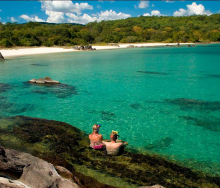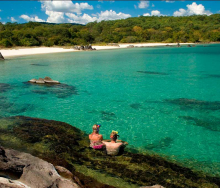An ancient beach at the Herculaneum archaeological park in the southern Italian region of Campania opened to the public last week after a multi-year restoration project.
The beach was destroyed by the eruption of Mount Vesuvius in 79AD. It is thought to be the site where more than 300 men tried in vain to save themselves from the natural disaster.
Human remains and other evidence of the eruption were discovered during the restoration work.
Like the nearby city of Pompeii, Herculaneum is famous as one of few ancient cities to have been preserved nearly intact, as the ash that blanketed the town protected it against looting and the elements.
Unlike Pompeii, Herculaneum was covered mainly in pyroclastic material that carbonised and preserved wooden objects such as roofs, beds, and doors, as well as other organic-based materials such as food and papyrus.
The newly opened beach area is one of multiple sites visitors can explore at Herculaneum. Other popular attractions open to the public include well-preserved baths, an underground theatre and residences with elaborate mosaics.















